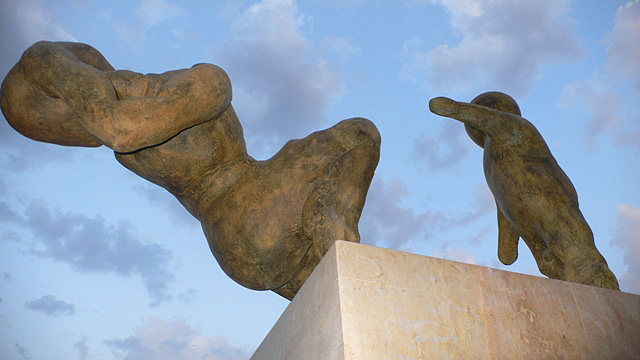The piece of the month of May 2011
"BREAKING LIFE. DEATH AND HELPLESSNESS".
MONUMENT TO THE VICTIMS OF TERRORISM. Juan José Aquerreta (2007)
Jorge Latorre Izquierdo
Audiovisual Communication. UN
Memorials are usually either grandiloquent or anodyne. These two extremes accompany in our time an art, the public and urban, which has much to do with the advertising, on the one hand, or with the decoration and urban counterpoint, on the other. In this case, neither of the two extremes are present. Although it is protected on a pedestal, the sculpture is not grandiloquent; in its placement next to the sidewalk, almost outside the place, it goes unnoticed to the light passerby. But neither is it anodyne: even observers who do not know how to distinguish the topic represented intuit that what it expresses is very dramatic, terrible. As with Picasso's Guernica, it is an art open to many interpretations, but it leaves no one indifferent; and in this way, polite but courageous, they send their message to those who would not like to hear it. In fact, Aquerreta's monument has received harsh criticism from those who do not condemn ETA's violence, and the artist himself had to endure a few insults after its inauguration. This happened on April 22, 2007, but the idea had been in the making for years, when Juan José Aquerreta saw in a newspaper a photo of a victim of ETA murdered with his son. He then decided to enter the ideas competition organized by the Tomás Caballero Foundation (named after a Pamplona councilman murdered by ETA in May 1998). A very well-selected jury (the director of the Prado Museum and the Oteiza Museum, among others) gave their votes, without knowing it, to the most prestigious artist from Navarre, award Nacional de las Artes Plásticas in 2001 and award Príncipe de Viana 2003; and allowed art to be combined with the commemorative, to the detriment of both the propagandistic and the decorative.

Juan José Aquerreta. Monument to the Victims of Terrorism. 2007
place of the Baluarte. Pamplona
Photograph Jorge Latorre
The award consisted of 6,000 euros, although taking it to the internship cost 180,000 euros, which were borne equally, 60,000 euros per institution, by the Government - UPN and CDN presented in Parliament an amendment to the General Budget, which had the support of all groups -, the City Council and the Tomás Caballero Foundation. They are data important, as they are part of the intrahistory of the commemorative monuments, and make them last more or less in time, together with the report that they seek to perpetuate. In this case, there is no doubt that what is at stake is the memory of the victims of ETA, which gives the work a palpitating topicality, after the last advertisement of cessation of armed violence, but not of hostilities (as no one has yet order pardon). The direct, aggressive and instantaneous style (he chooses the very moment of the shot, although the murderer is excluded in the whole), contrasted greatly with the usual aesthetics of Aquerreta's sculpture, which tends to be static, timeless. In this case, the deformed mass of the dead figure (it can be either a man or a woman) spills out of its pedestal over the eyes of the passerby. The child, witness to the murder of his father, initiates the gesture of an embrace, representing the "helplessness of those who remain and the impossible intelligence of this act," as the artist himself explained on the opening day. Tomás Caballero Martínez, president of the Foundation that bears his father's name, added the following: "we are the child of the sculpture insofar as we pick up the bequest of dignity and democracy of the falling figure". But the murderers themselves are also victims of violence, as Juan José Aquerreta narrates in the documentary Últimamente (Conversations with Navarrese Artists, 2009) when comparing the monument with the Diptych of the Martyrdom of Saint Stephen that he is painting for the church of Gorraiz: "I made the monument because I feel very identified with the victims, since in some way one is a victim of his own history (...) The topic of the diptych is society against the free person, exactly the same as that of the monument to the victims of terrorism. The man who says "I have seen the open sky" is saying that his freedom is in relation to God; that is to say, that his totality is a function of individual freedom, and it is the whole society of the wise that is going to assassinate him. That is why he shares the reality of the man who fights for freedom, from the plane of religion in this case, and in the other, on the plane of politics. I am trying to make sure that priests have a human face, that they are serene, even beautiful people, because sometimes we all act like that, putting ideology ahead of love for people, and respect for people's freedom."
bibliography
AA.VV. "Conversations with Navarrese artists: Juan José Aquerreta", Últimamente. Government of Navarra, 2007.
Juan José Aquerreta, Últimamente, DVD published by the Government of Navarra, 2009.
J. L. "Interview with Juan José Aquerreta", Arte y Parte, n. 80, April-May 2009, pp. 44-51.
